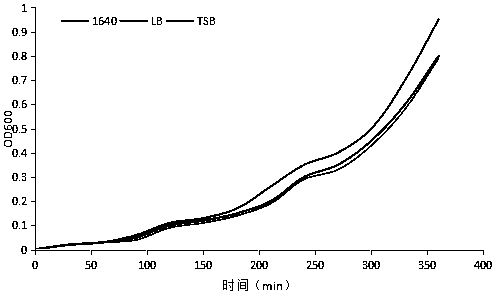High-throughput rapid antimicrobial susceptibility test kit for veterinary clinical application
A detection kit and drug susceptibility technology, applied in the field of veterinary detection reagents, can solve problems such as time-consuming, inability to test antibiotic susceptibility, complicated operation steps, etc., and achieve the effects of intuitive results, easy observation, enrichment, and easy operation.
- Summary
- Abstract
- Description
- Claims
- Application Information
AI Technical Summary
Problems solved by technology
Method used
Image
Examples
Embodiment 1
[0144] Based on the sterilized 1640 medium, LB and TSB medium respectively, add 1% sterile calf serum and 1‰ sterile NAD. Inoculate clinically common Escherichia coli, Haemophilus parasuis (HPS) and Actinobacillus (APP) as the research objects, measure the OD600 absorbance value every 1 hour, measure each test tube three times, and draw the growth curve by taking the average value , to select the medium suitable for the rapid growth of most bacteria. Such as figure 1 As shown, the growth rate of Haemophilus parasuis on the 1640-based rapid enrichment medium is faster, it is easier to observe the enrichment, and at the same time, the influence of the color of LB and TSB medium on the results is reduced. Actinobacillus pleuropneumoniae and Haemophilus parasuis had the same trend. For E. coli, there was no difference between the 1640-based rapid enrichment medium and the LB medium.
Embodiment 2
[0146] Taking the Cmax of the drug in the blood after intramuscular injection of pigs at the normal dosage, the Cmax of the drug was coated on a 96-well ELISA plate with 2 times the Cmax and 1 times the Cmax respectively, and then freeze-dried to prepare a drug sensitivity detection plate.
[0147] Taking Escherichia coli, Actinobacillus pleuropneumoniae and Haemophilus parasuis as objects, the kit of the invention is used to detect the antibiotic sensitivity of Escherichia coli, Actinobacillus pleuropneumoniae and Haemophilus parasuis. Escherichia coli, Actinobacillus pleuropneumoniae and Haemophilus parasuis were respectively cultured on 1640-based rapid growth medium for 1 hour, 3 hours and 4 hours, and then 100 μL (2 drops) was added to the drug-sensitive plate. After incubating at 37° C. for 16 hours, 50 μL (1 drop) of 0.2% resazurin sterile solution was added to each well, and the results were read after incubating at 37° C. for 1.5 hours. The susceptibility results of v...
Embodiment 3
[0149] a. Use sterile cotton swabs to collect disease materials (in order to shorten the culture time of enrichment, collect as much as possible), add to the enrichment medium, and incubate at 37°C for 2-6h, when the colorless medium becomes slightly turbid ( About 0.5 McFarland turbidity, Figure 5 ), proceed to the next step; for stool samples, let stand for 30 minutes after collection, take 50-100 μL (1-2 drops) of the supernatant and add it to the enrichment medium; for blood samples, after standing for 30 minutes, take 50 μL of serum -100μL (1-2 drops) was added to the enrichment medium.
[0150] b. Add 100 μL (2 drops) of the cultured bacterial solution to each well of the coated drug-sensitivity plate, and incubate at 37°C for 16 hours;
[0151] c. Take out the drug sensitivity plate, add 50 μL (1 drop) of 0.2% resazurin sterile solution to each well, incubate at 37°C for 1.5 hours and read the results;
[0152] d. Judgment of drug susceptibility results: blue means c...
PUM
 Login to View More
Login to View More Abstract
Description
Claims
Application Information
 Login to View More
Login to View More - R&D
- Intellectual Property
- Life Sciences
- Materials
- Tech Scout
- Unparalleled Data Quality
- Higher Quality Content
- 60% Fewer Hallucinations
Browse by: Latest US Patents, China's latest patents, Technical Efficacy Thesaurus, Application Domain, Technology Topic, Popular Technical Reports.
© 2025 PatSnap. All rights reserved.Legal|Privacy policy|Modern Slavery Act Transparency Statement|Sitemap|About US| Contact US: help@patsnap.com



